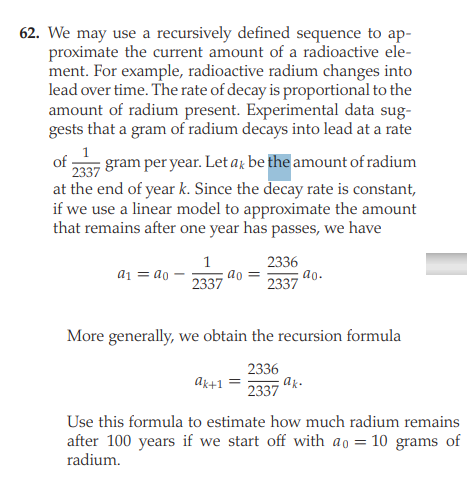62. We may use a recursively defined sequence to ap- proximate the current amount of a radioactive ele- ment. For example, radioactive radium changes into lead over time. The rate of decay is proportional to the amount of radium present. Experimental data sug- gests that a gram of radium decays into lead at a rate of gram per year. Let a; be the amount of radium 2337 at the end of year k. Since the decay rate is constant, if we use a linear model to approximate the amount that remains after one year has passes, we have 2336 ao. 2337 1 a1 = ao - 2337 ao More generally, we obtain the recursion formula 2336 ak+1 2337 Use this formula to estimate how much radium remains after 100 years if we start off with ao radium. 10 grams of
62. We may use a recursively defined sequence to ap- proximate the current amount of a radioactive ele- ment. For example, radioactive radium changes into lead over time. The rate of decay is proportional to the amount of radium present. Experimental data sug- gests that a gram of radium decays into lead at a rate of gram per year. Let a; be the amount of radium 2337 at the end of year k. Since the decay rate is constant, if we use a linear model to approximate the amount that remains after one year has passes, we have 2336 ao. 2337 1 a1 = ao - 2337 ao More generally, we obtain the recursion formula 2336 ak+1 2337 Use this formula to estimate how much radium remains after 100 years if we start off with ao radium. 10 grams of
Algebra & Trigonometry with Analytic Geometry
13th Edition
ISBN:9781133382119
Author:Swokowski
Publisher:Swokowski
Chapter10: Sequences, Series, And Probability
Section10.3: Geometric Sequences
Problem 81E
Related questions
Question

Transcribed Image Text:62. We may use a recursively defined sequence to ap-
proximate the current amount of a radioactive ele-
ment. For example, radioactive radium changes into
lead over time. The rate of decay is proportional to the
amount of radium present. Experimental data sug-
gests that a gram of radium decays into lead at a rate
of
gram per year. Let a; be the amount of radium
2337
at the end of year k. Since the decay rate is constant,
if we use a linear model to approximate the amount
that remains after one year has passes, we have
2336
ao.
2337
1
a1 = ao -
2337
ao
More generally, we obtain the recursion formula
2336
ak+1
2337
Use this formula to estimate how much radium remains
after 100 years if we start off with ao
radium.
10 grams of
Expert Solution
This question has been solved!
Explore an expertly crafted, step-by-step solution for a thorough understanding of key concepts.
Step by step
Solved in 2 steps

Recommended textbooks for you

Algebra & Trigonometry with Analytic Geometry
Algebra
ISBN:
9781133382119
Author:
Swokowski
Publisher:
Cengage



Algebra & Trigonometry with Analytic Geometry
Algebra
ISBN:
9781133382119
Author:
Swokowski
Publisher:
Cengage




College Algebra (MindTap Course List)
Algebra
ISBN:
9781305652231
Author:
R. David Gustafson, Jeff Hughes
Publisher:
Cengage Learning